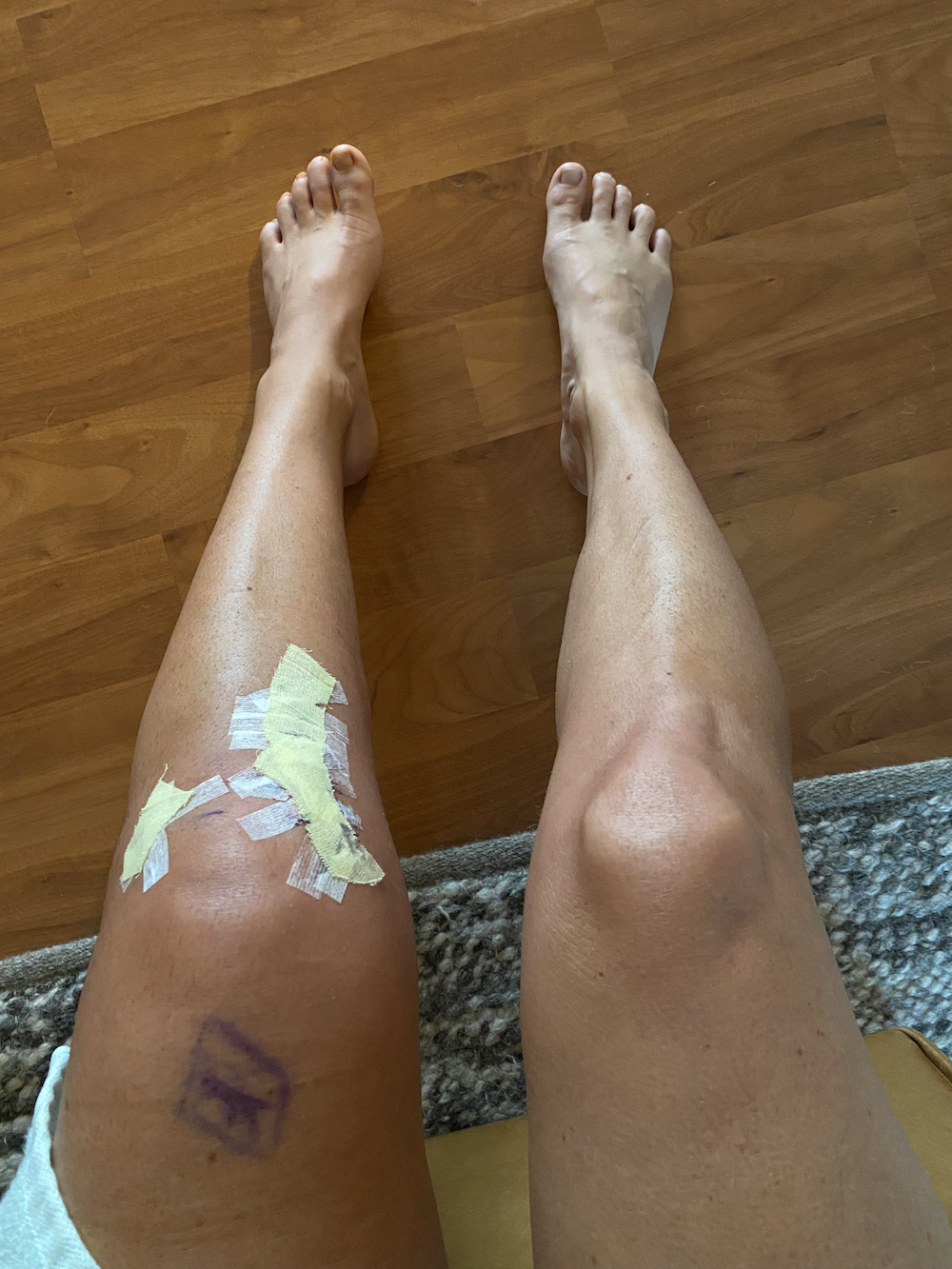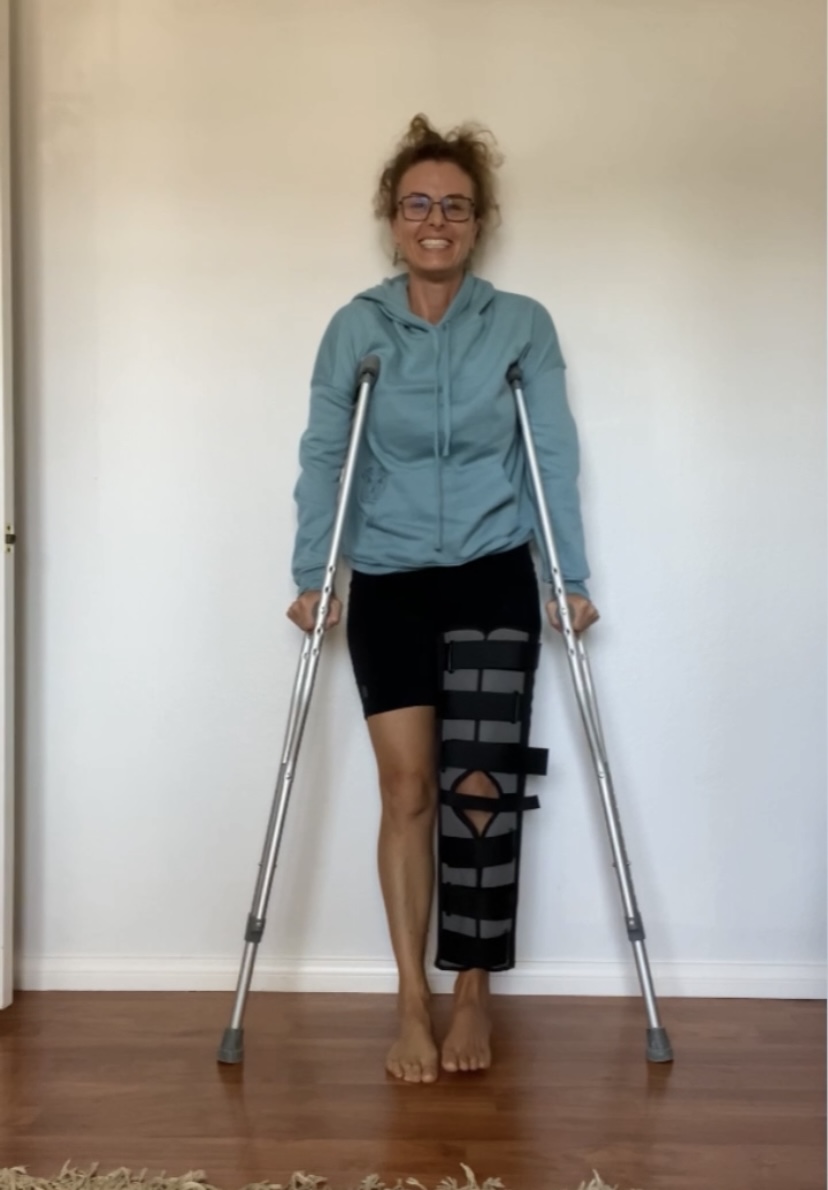
Yoga Post ACL Surgery
Jan 11, 2023In March 2022, I experienced my worst injury when I completely tore my ACL and meniscus while skiing.
Since then, my yoga practice has been an exploration of what I can and can’t do, and it fluctuates daily. This blog is intended to help you learn how to practice (or when not to practice) while dealing with your own injuries.
Immediately following the injury, I rested for a few days, as is necessary any time you have an acute injury. Your body needs to use its energy to heal at this time, not to do yoga. Afterward, I modified my practice, including seated sun salutations, straight-leg yoga poses, and backbends. My knee was still swollen, and putting weight on it was painful. Had I realized that my ACL was completely torn, I would have waited longer before resuming.
I was gradually able to add back many poses. Second Series felt reasonably good, while the Primary Series felt awful. With a torn ACL, pivoting side to side in standing poses hurts—it feels like your leg might collapse under your weight at any moment or that the knee will hyperextend, leaving your lower leg detached from the rest of your body.
As the swelling went down, I continued improving my practice and eventually could do a mix of poses from the second, third, and even fourth series. However, my practice was never rigorous after the injury, mainly because I couldn’t jump much and could no longer perform jump backs. I couldn’t bend my knee enough even to entertain the idea.
I couldn’t have ACL repair surgery for five months, and I felt I needed my ACL intact, even though both doctors I met with said I could return to full yoga practice without it. I brought a cheat sheet of Second Series poses to all my appointments and made that my range of motion goal.
In August, I finally had surgery. I opted for a cadaver graft to avoid a second injury to my leg if they used one of my ligaments. The surgeon was able to stitch my meniscus, which is highly unusual, and the surgery, thankfully, went well. The stitched meniscus significantly slows down the recovery time. I couldn't put any weight on the leg for three weeks and I was on crutches for seven weeks.

The doctors gave me a nerve block before the surgery, so I didn’t feel much in my leg during the first twenty-four hours post-operation. When the sensation returned, it was mostly my hip that hurt because of how it had been positioned during surgery. I was told to flex and point my feet to get the blood moving and to put no weight on the leg for three weeks. Thus, I was resigned to the couch. I didn’t shower for days, necessary tasks like going to the bathroom were challenging and required help, and essential household duties were put on hold.

I started physical therapy four days after surgery. The hardest part was getting there; at this point, I was in a leg immobilizer and fairly bad at using crutches. There wasn’t much for the PT to help me with because I could do so little. The first exercise he assigned me was to flex my quad. You can’t activate your quad or hamstring when you tear your ACL—it’s a bizarre sensation. This led to immediate atrophy in the leg; my calf and quad muscles immediately disappeared. Because my leg couldn’t use its muscles to lift itself, I experienced extreme hip discomfort. To move my leg, I had to physically pick it up with my hands. It was a humbling experience to go from being so aligned with my body to feeling limited by it.
I spent my days on the couch reading, watching TV, and crying. Not being able to do the things that regulate my mood, like walking around Hampi, going to the beach, and practicing yoga, was incredibly hard for me. I religiously meditated and chanted, but that wasn’t enough to keep me in a good headspace. I did what Pilates I could; since Pilates is done lying down and isolates specific body parts, I was able to return to Pilates sooner than yoga.


As instructed, I did my PT exercises consistently and stayed off my leg. After nearly seven weeks on crutches, I started to walk on my own again. Almost two months post-op, I finally did my first yoga practice. It was slow and deliberate, but there’s nothing wrong with that. As soon as I began, the pain in my hamstring attachment subsided, and I started to feel more like myself. My first headstand felt terrific. Moving my legs in this position helped open my hip in a way that isn’t possible while it’s supporting weight.
Today, I’m five months post-op. I’m still regaining the strength I lost while on crutches for so long, and I practice asana about four times a week. Occasionally, I do too much and have a little setback, as I’m weaker now and have tendinitis in my hip. Now I’m going to the gym, riding the stationary bike, lifting a few weights (I even got a trainer!), and doing my PT exercises. I’m gradually rebuilding my practice, but it takes time. I’ve lost a lot of strength in my entire body, but if there’s one thing I have learned from all of this, it’s that the body is impermanent and will inevitably change again.
I can finally kneel again, which means I can do some of the backbends of the Second Series. This series is my best friend for now; it will be a while before I can do Primary again. Most people with a similar injury experience have told me to plan to wait a year to a year and a half after surgery to feel normal again.
I was talking to a teacher who had ACL surgery years ago, and she told me that one day I will wake up, and my knee won’t be the first thing I think about and that, eventually, I won’t think about it at all. It will just be my knee again. I’m greatly looking forward to that day.
In short, sometimes, the right thing to do is not practice. We hear that Ashtanga is a six-day-a-week practice, and you can undoubtedly modify, use props, and make the practice fit your body, but there are also times when no practice is best. Learn your body and your limitations so that you can decide for yourself. Asana isn’t everything; zoom out and look at the big picture. Do you want to be practicing five years from now? A decade? Two decades? If so, you must prioritize the future over your immediate desire to practice.
Your body is a healing machine! If it weren’t, you wouldn’t be here. I have seen students return to practice after enduring seemingly insurmountable obstacles: mastectomies, difficult C-sections, surgeries, and even amputation. Don’t think you will be the exception; your body will heal, too, and practice will be there when you’re ready.
Listen to your body and reevaluate often. Focus on what you can do, and know that this will change daily. Practice patience, as difficult as that may be.
Reinvent Ashtanga so it works for you, not against you, and aim to find a teacher who can support you through it all.
Registration is open for Primary Series Interactive Online Course. Read more and sign up here. We start January 28.
Stay connected with news and updates!
Join our mailing list to receive the latest news and updates from our team.
Don't worry, your information will not be shared.
We hate SPAM. We will never sell your information, for any reason.



